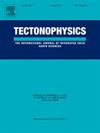基于地震和大地测量资料的喜马拉雅-西藏碰撞带综合应力应变特征
IF 2.7
3区 地球科学
Q2 GEOCHEMISTRY & GEOPHYSICS
引用次数: 0
摘要
喜马拉雅-西藏碰撞带(HTCZ)是地球上地球动力学最活跃的地区之一,由印度板块和欧亚板块之间的持续碰撞形成。本文通过将地震震源机制解(FMS)与全球导航卫星系统(GNSS)的速度数据相结合,分析了HTCZ地区的主要地应力和变形模式。利用迭代法和阻尼法对FMS数据进行反演,发现喜马拉雅弧形带以低角度俯冲为主的南北向挤压应力为主。青藏高原则表现为走滑和正断层的组合,应力方向为西西北东向。为了更好地理解变形模式,采用改进的加权最小二乘法对gnss导出的速度数据进行反演,以估计区域应变率。由此得到的扩张应变率图也突出了沿喜马拉雅弧的地壳明显缩短,而青藏高原则表现出伸展。而最大剪切应变速率主要是由走滑断裂引起的。第二张不变应变率图显示喜马拉雅中部和喜马拉雅东部合带的变形集中程度最高。FMS得到的最大水平压应力方向(SHmax)与GNSS速度得到的最大水平缩短应变速率方向(εHmax)基本一致。在75°E ~ 95°E经度范围内,SHmax和εHmax具有较强的相关性,表明HTCZ中部具有较高的弹性。然而,在东段明显的顺时针旋转的SHmax和εHmax强调了青藏高原下黏性岩石圈的存在。这些发现为喜马拉雅应力-应变机制提供了有价值的见解,并增强了我们对这个高度动态构造带的地壳变形过程的理解。本文章由计算机程序翻译,如有差异,请以英文原文为准。
Integrated stress and strain characterisation of the Himalayan-Tibetan collision zone using earthquake and geodetic data
The Himalayan-Tibetan Collision Zone (HTCZ) is one of the most geodynamically active regions on Earth, shaped by the continuous collision between the Indian and Eurasian plates. This study analyzes the prevailing crustal stress and deformation patterns across the HTCZ by integrating earthquake focal mechanism solutions (FMS) with velocity data from the geodetic Global Navigation Satellite System (GNSS). Inversion of FMS data, using iterative and damped methods, reveals a dominant N-S oriented compressional stress with low-angle plunges along the Himalayan Arc. In contrast, the Tibetan Plateau exhibits a combination of strike-slip and normal faulting with WNW-ESE stress orientations. To better understand deformation pattern, GNSS-derived velocity data were inverted using a modified weighted least-squares approach to estimate regional strain rates. The resulting dilatation strain rate map too highlights the significant crustal shortening along the Himalayan Arc, while the Tibetan Plateau displays extension. However, the maximum shear strain rates are primarily attributable to strike-slip faulting in Tibetan region. Additionally, the second invariant strain rate map indicates the highest deformation concentrations in the central Himalaya and the eastern Himalayan syntaxis. The maximum horizontal compressive stress orientations (SHmax) derived from FMS closely align with the maximum horizontal shortening strain-rate orientations (εHmax) inferred from GNSS velocities. The strong correlation between SHmax and εHmax within the 75°E to 95°E longitude suggests the high elasticity of the central segment of HTCZ. However, the noticeable clockwise rotation of SHmax and εHmax over the eastern segment underscores the presence of a viscous lithosphere beneath the Tibetan Plateau. These findings provide valuable insights into the Himalayan stress-strain regime and enhance our understanding of crustal deformation processes in this highly dynamic tectonic zone.
求助全文
通过发布文献求助,成功后即可免费获取论文全文。
去求助
来源期刊

Tectonophysics
地学-地球化学与地球物理
CiteScore
4.90
自引率
6.90%
发文量
300
审稿时长
6 months
期刊介绍:
The prime focus of Tectonophysics will be high-impact original research and reviews in the fields of kinematics, structure, composition, and dynamics of the solid arth at all scales. Tectonophysics particularly encourages submission of papers based on the integration of a multitude of geophysical, geological, geochemical, geodynamic, and geotectonic methods
 求助内容:
求助内容: 应助结果提醒方式:
应助结果提醒方式:


